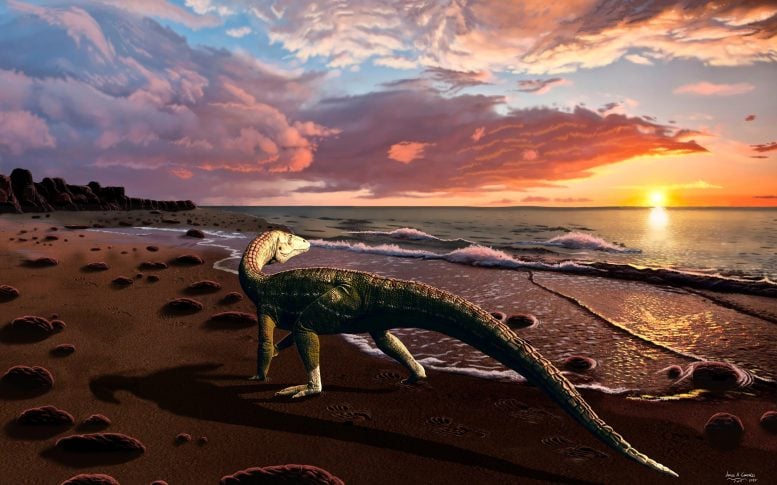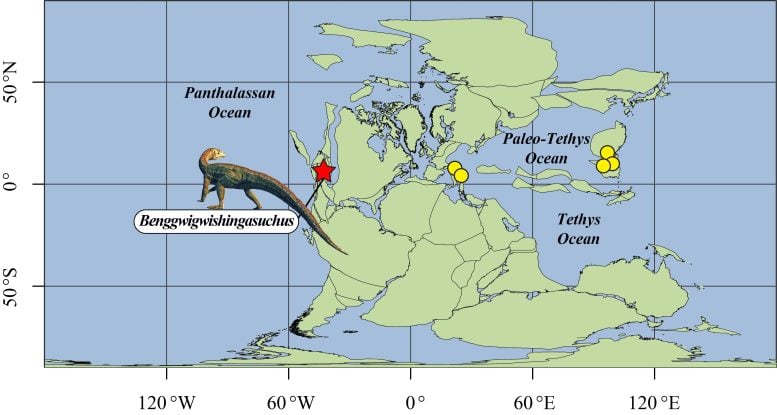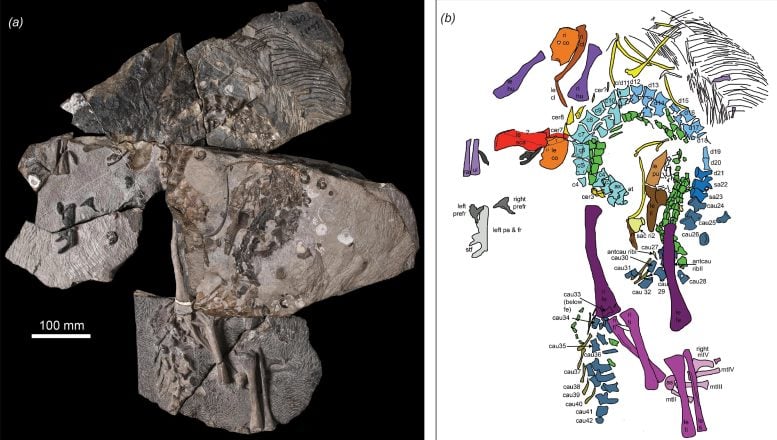
Benggwigwishingasuchus eremicarminis on the coast of the Panthalassan Ocean. Credit: Jorge Gonzalez
A new discovery
” data-gt-translate-attributes=”({“attribute”:”data-cmtooltip”, “format”:”html”})” tabindex=”0″ role=”link”>Trias A crocodile relative demonstrates that pseudosuchian archosaurs inhabited global coastal areas, greatly enriching our understanding of
” data-gt-translate-attributes=”({“attribute”:”data-cmtooltip”, “format”:”html”})” tabindex=”0″ role=”link”>Mesozoic marine ecosystems.
Researchers have discovered a new
” data-gt-translate-attributes=”({“attribute”:”data-cmtooltip”, “format”:”html”})” tabindex=”0″ role=”link”>species of an extinct relative of the crocodile from the Triassic Favret Formation of Nevada, United States. The species, named Benggwigwishingasuchus eremicarminisreveals that ancient relatives of crocodiles known as pseudosuchian archosaurs dominated the globe’s shores in the Middle Triassic period between 247.2 and 237 million years ago. The finding, detailed in a study published July 10 in Biology lettersreshapes our understanding of coastal ecosystems at the beginning of the dinosaur era.
“This exciting new species demonstrates that pseudosuchians occupied coastal habitats globally during the Middle Triassic,” said Dr. Nate Smith, lead author of the paper, and Gretchen Augustyn, director and curator of the Dinosaur Institute at the Natural History Museum of Los Angeles County.
Discovering pseudosuchian diversity
The majority of fossils from the Triassic eastern Panthalassan Ocean, which includes the Favret Formation, are those of marine creatures such as ammonites or marine reptiles like the giant ichthyosaur. C. youngorum. Therefore, the discovery of the newly described terrestrial species B. eremicarminis It was completely unexpected.
“Our first reaction was to ask ourselves what was this thing?” said Nicole Klein, co-author of the study and professor at the University of Bonn. “We expected to find marine reptiles. We didn’t understand how a land animal could be found so far out in the sea, among ichthyosaurs and ammonites. It was only when I saw the almost completely prepared specimen that I was convinced that it was indeed a land animal.”

Map of Middle Triassic oceans and described archosauriforms from eastern coastal areas (yellow dots), as well as the new species B. eremicarminis from the Panthalassan coast (red star). Credit: Nate Smith
Fossil discoveries shed light on evolution
Pseudosuchian archosaurs have been discovered in fossil deposits on the coasts of the ancient Tethys Ocean, but this is the first coastal representative from the Panthalassan Ocean and the Western Hemisphere, revealing that these crocodile relatives were present in coastal environments worldwide during the Middle Triassic. Interestingly, these coastal species are not all from the same evolutionary group, suggesting that pseudosuchians (and archosauriforms more broadly) adapted independently to life along coasts.
“It seems that several very different groups of archosauriforms decided to go into the water during the Middle Triassic. What’s interesting is that it doesn’t seem like many of these ‘independent experiments’ led to broader radiations of semi-aquatic groups,” Smith said.

B. eremicarminis specimen a) skeletal overview; b) color-coded interpretation of the skeleton. Credit: Photograph by Stephanie Abramowicz; drawing by Dr. Nicole Klein
Revealing ancient adaptations and diverse forms
During the Triassic, archosaurs, “the dominant reptiles,” appeared and split into two groups with two surviving representatives: birds, descendants of dinosaurs, and crocodilians (alligators, crocodiles, and gharials), descendants of pseudosuchian archosaurs like B. eremicarminisAlthough today’s crocodilians are similar enough to be confused by most people, their ancient relatives varied enormously in size and lifestyle. B. eremicarminis and its relatives suggest that pseudosuchians reached high diversity very quickly after the end-Permian mass extinction, the extent of which awaits discovery in the fossil record.
“A growing number of recent discoveries of Middle Triassic pseudosuchians suggest that underappreciated morphological and ecological diversity and experiments occurred early in the group’s history. While much of the public fascination with the Triassic focuses on the origin of dinosaurs, it was actually pseudosuchians that did interesting things in the early Mesozoic,” Smith said.
Explore the ecology of B. eremicarminis
The new species highlights the multiplicity of these ancient reptiles during the Triassic, from giants like Mambawkale Spirit to smaller animals such as those recently described B. eremicarminiswhich probably reached about 1.5 to 1.8 m in length. How long exactly B. eremicarminis How he looked and how he survived along the coasts remains obscure in the past. Only a few elements of the individual’s skull have been found, and any clues as to how he fed and hunted are also absent. What is clearer is that B. eremicarminis probably stuck fairly close to shore. Its well-preserved limbs are well developed with no signs of aquatic life such as fins or altered bone density.
The research team wanted a name that would honor the early human inhabitants of the Augusta Mountains where the specimen was found, and so consulted with a member of the Fallon Paiute Shoshone tribe to decide on an appropriate name. “Benggwi-Gwishinga,” a word meaning “to catch fish” in Shoshone, was combined with the Greek word for Sobek, the crocodile-headed Egyptian god, to create the new genus, Benggwig wishing unsuchus. The specific epithet hermitage translates to “song of the desert,” in homage to two NHMLAC supporters who have a passion for paleontology and Southwestern opera. Thus, the full name is supposed to roughly translate to “Desert Song of the Fishing Crocodile.”
Reference: “A new pseudosuchian from the Favret Formation of Nevada reveals that archosauriforms occupied coastal regions worldwide during the Middle Triassic” by Nathan D. Smith, Nicole Klein, P. Martin Sander, and Lars Schmitz, July 10, 2024, Biology letters.
DOI: 10.1098/rsbl.2024.0136